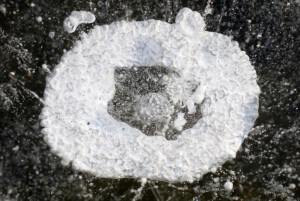
Frozen air bubbles are trapped under ice at Tenney Park. Clear ice — such as hazardous black ice — has no air bubbles in it, while lots of trapped air makes an object look white. (Photo credit: Mike Devries, The Capital Times archives)
The ice is clear because no air bubbles are trapped in the ice. Lots of trapped air makes an object look white. Snow looks white because of air trapped between crystals.
The danger of driving on a road covered with black ice is that it can appear to be merely wet.
Drivers may not recognize the slippery conditions until it is too late and their car begins to skid.
If your car has a thermometer, its temperature reading can help you determine hazardous road conditions. If your car’s thermometer measures an air temperature near freezing, you should be wary of the road conditions.
Also, because bridges span the open air, they cool faster than the roadways around them. So, black ice may first occur on bridges. Hence the warning signs “Bridge May Freeze Before Road.”
If a sidewalk is covered with clear ice, it may look dark gray — like a wet sidewalk. This “grey ice” can be hazardous for walking.

